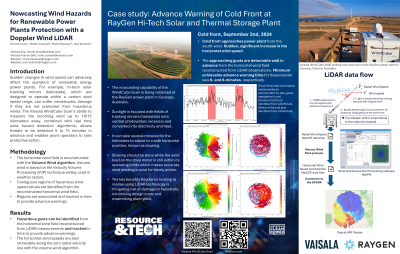Back

Nowcasting Wind Hazards for Renewable Power Plants Protection with a Wind Doppler Lidar
Tuesday, October 1, 2024
5:00 PM – 6:00 PM MST
Location: Regency D

- RC
Robin Conseil
Field Service Project Manager - Worldwide
Vaisala
Poster Presenter(s)
Presentation Description: Sudden wind regime changes in speed or direction are difficult to predict and can severely affect the operation of renewable power plants. It impacts PV and hi-tech solar trackers which are designed to operate up to a maximum wind speed threshold. When catastrophic damages occur, losses can account for hundreds thousands of dollars. Using the Vaisala WindCube Scan ability capability to measure the incoming wind up to a distance of 10/15km, threats can be detected 5 to 15minutes in advance. That requires real time detection algorithm of wind hazards.
A real time reconstruction of 3D wind fields with one single Wind Doppler Lidar can be achieved using the Volume Wind reconstruction algorithm (VW). It is based on the Volume Velocity Processing (VVP) technique used for years for Weather Radars, the VW algorithm reconstructs the wind vectors (U, V) at any point located in the hemisphere around the Lidar sensor in combining the radial wind speeds measured at different range gates.
The nowcasting capability of WindCube Scan is studied at the RayGen Power Plant at Carwarp in Australia. This farm combines solar power with thermal hydro storage. The Heliostat mirrors are angled to focus sunlight at solar modules installed at the top of towers. The Heliostat mirror control drives have a maximum operational wind speed. Depending on what orientation they are in; it can take up to a few minutes for them to move into a safe horizontal stowed position, whereas wind speed can increase almost instantaneously. The presented study will first characterize what type of wind events lead to stowed events. And then assess the performance wind doppler lidar to detect and alert for wind hazards.
A real time reconstruction of 3D wind fields with one single Wind Doppler Lidar can be achieved using the Volume Wind reconstruction algorithm (VW). It is based on the Volume Velocity Processing (VVP) technique used for years for Weather Radars, the VW algorithm reconstructs the wind vectors (U, V) at any point located in the hemisphere around the Lidar sensor in combining the radial wind speeds measured at different range gates.
The nowcasting capability of WindCube Scan is studied at the RayGen Power Plant at Carwarp in Australia. This farm combines solar power with thermal hydro storage. The Heliostat mirrors are angled to focus sunlight at solar modules installed at the top of towers. The Heliostat mirror control drives have a maximum operational wind speed. Depending on what orientation they are in; it can take up to a few minutes for them to move into a safe horizontal stowed position, whereas wind speed can increase almost instantaneously. The presented study will first characterize what type of wind events lead to stowed events. And then assess the performance wind doppler lidar to detect and alert for wind hazards.
